I don’t see tambourine doves in the garden as much as I used to and in any event they are shy and skittish, so the other day when I looked out of the window and saw a tambourine dove foraging on the ground I fetched my camera.
At first, the tambourine dove (Turtur tympanistria) was at quite some distance and picking up seeds among the fallen fruits of a tree fuchsia (Halleria lucida). It was unaware of me watching it from a window and unusually it came out into the open to enjoy some sunbathing before coming closer still as it looked for food in the lawn.
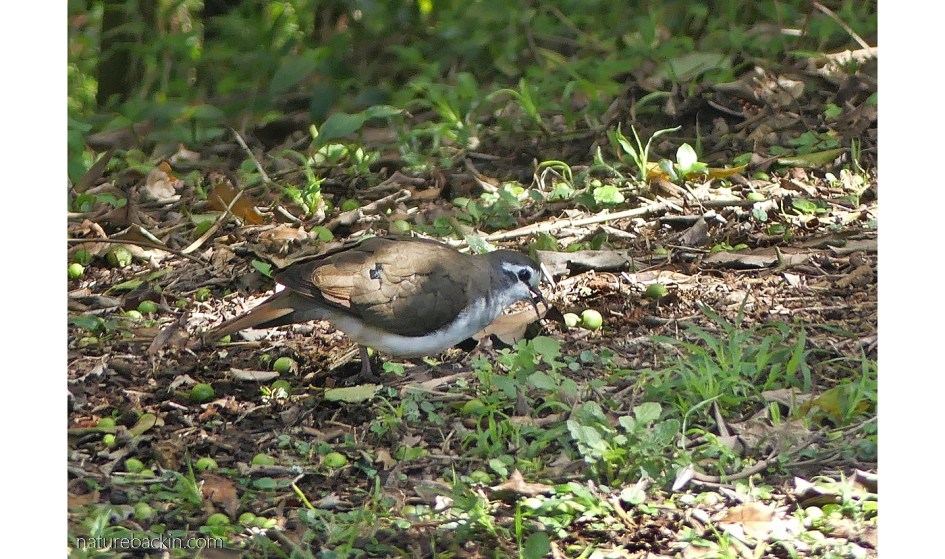
Difficult to photograph in dappled light and quite some distance away, the tambourine dove was eating fallen seeds among green fruits from a tree fuchsia that had dropped from the tree. Tambourine doves mostly forage on the ground, eating seeds and fruits. They are also known to eat termites and molluscs.
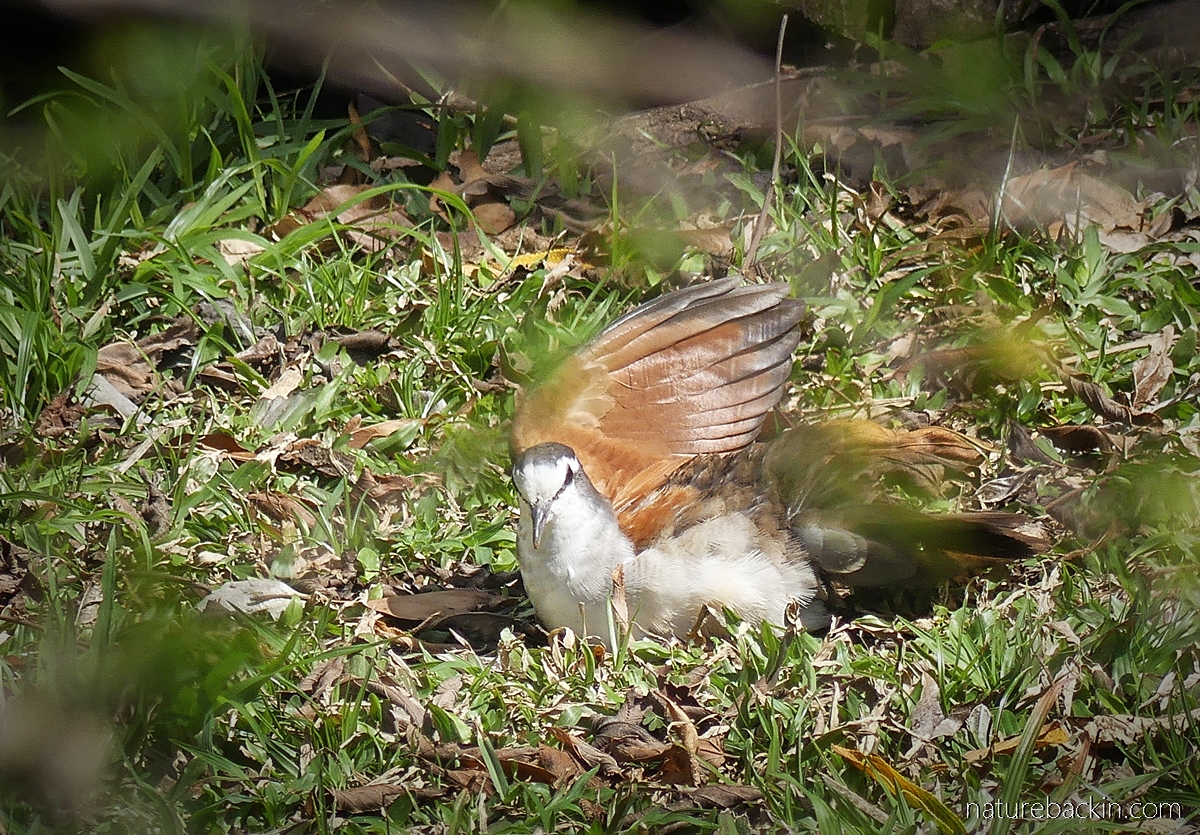
Unexpectedly, the tambourine dove moved out into the sunshine and lifted a wing as it sunbathed. The wings are an unexpected auburn in colour and are in striking contrast to the bright white face, throat and underparts.
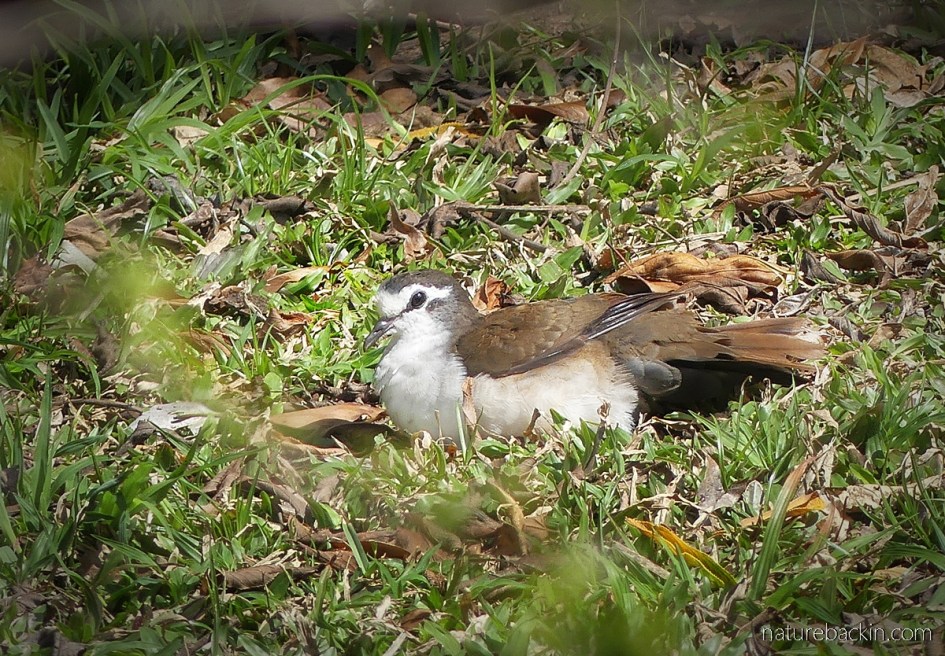
The dove closed its wings and stayed motionless for a time, apparently enjoying the sunshine. The male dove is very white on the face, throat and underparts, whereas the female has a buffy grey wash on the upper breast and throat.
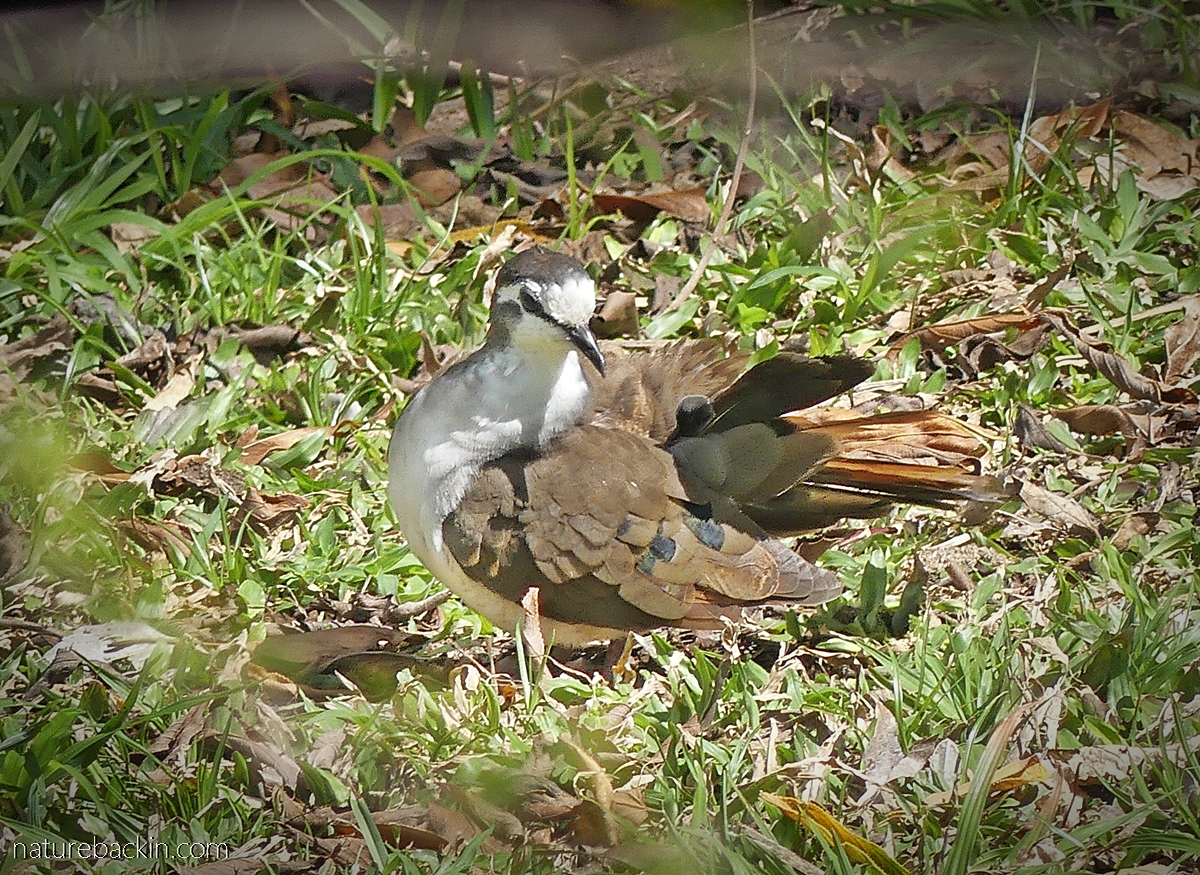
After sunbathing for a while, the tambourine dove stood up to indulge in a brief preening session. The dark almost purple iridescent spots on the wings can be seen.
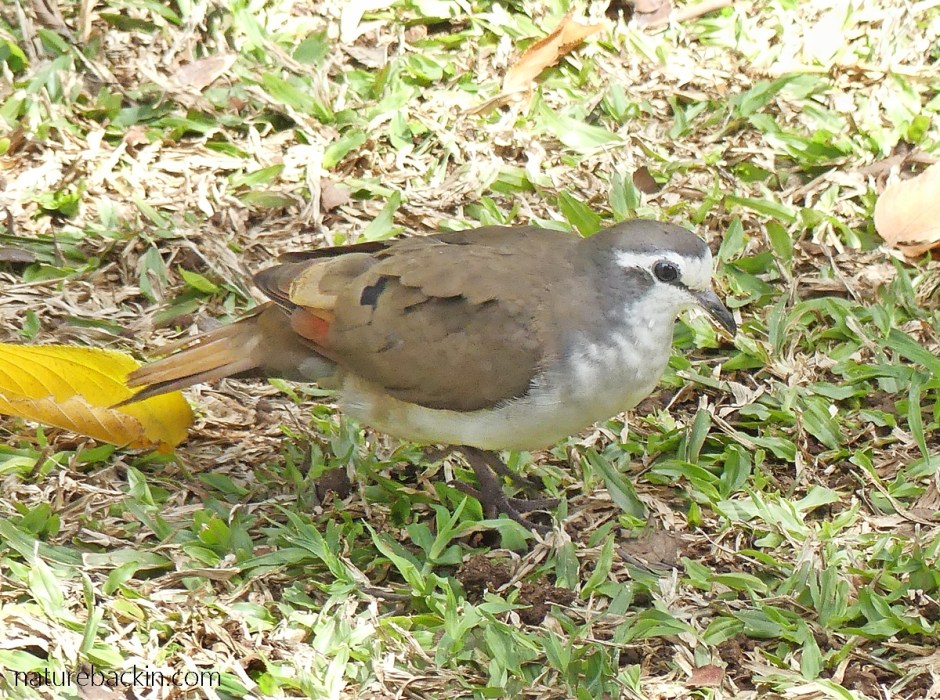
The tambourine dove then moved closer to forage on the lawn in a patch of shade. When closer, the dove did seem to become aware of my presence behind the window, as can be seen in the header photo where the dove seems to be glancing in my direction.
Regarding the name ‘tambourine dove’, both the common name and the scientific name, Turtur tympanistria, refer to the dove’s rhythmic and resonating call. In Ancient Greek mythology, Timpanistria was the name of a priestess who used drums and tambourines in ceremonies honouring the goddess Cybele. For recordings of the call of the tambourine dove go to https://www.xeno-canto.org/explore?query=tambourine%20dove
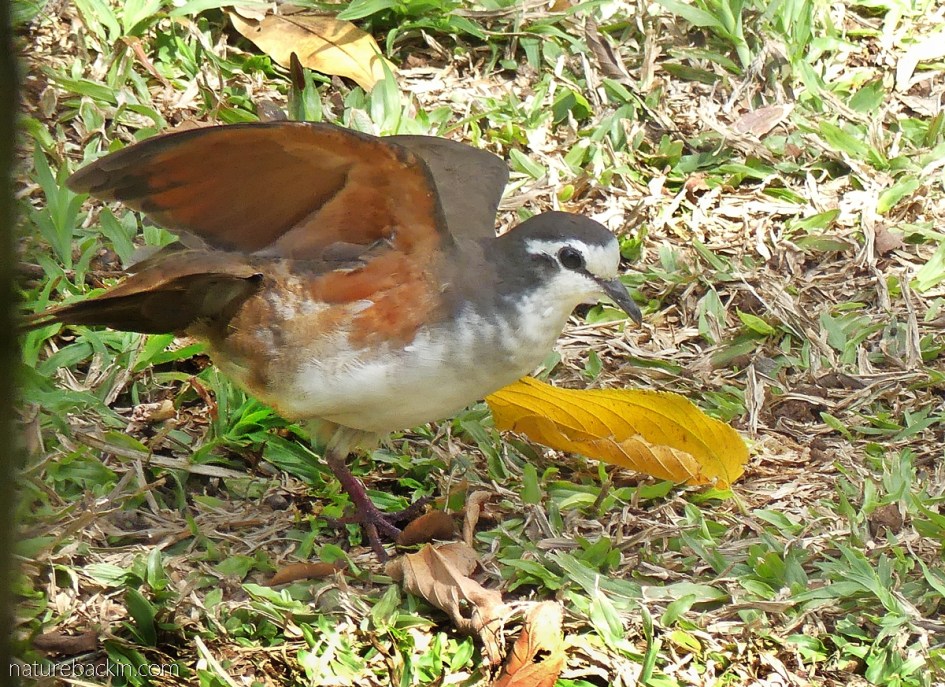
Although seemingly aware of my presence, suddenly the tambourine dove stretched out one leg and lifted its wings, displaying the auburn colouring of the wings once again.
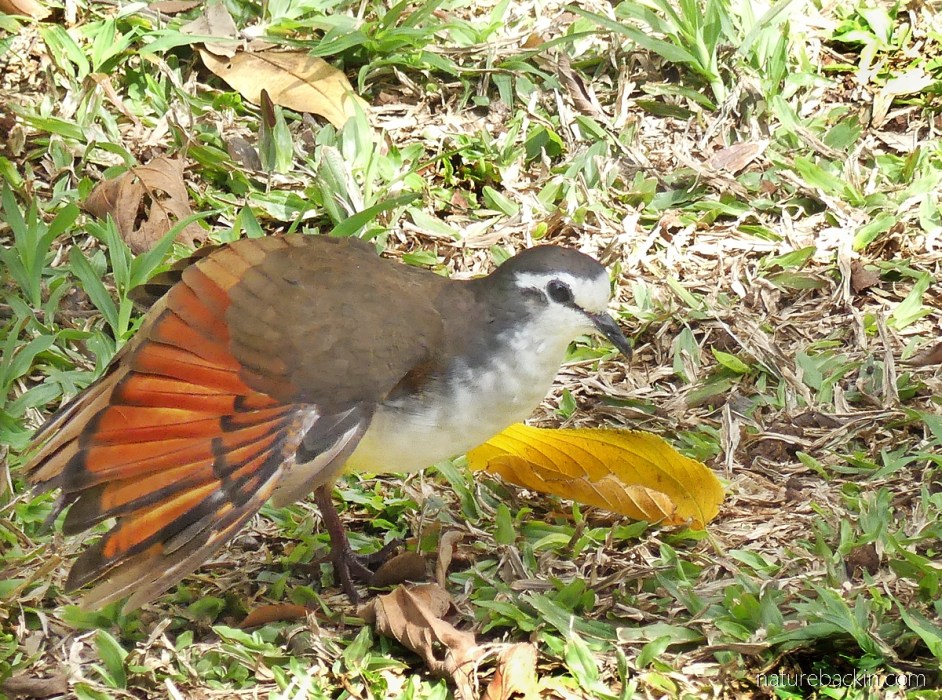
It then completed its stretching by fanning out one wing showing the beautiful plumage.
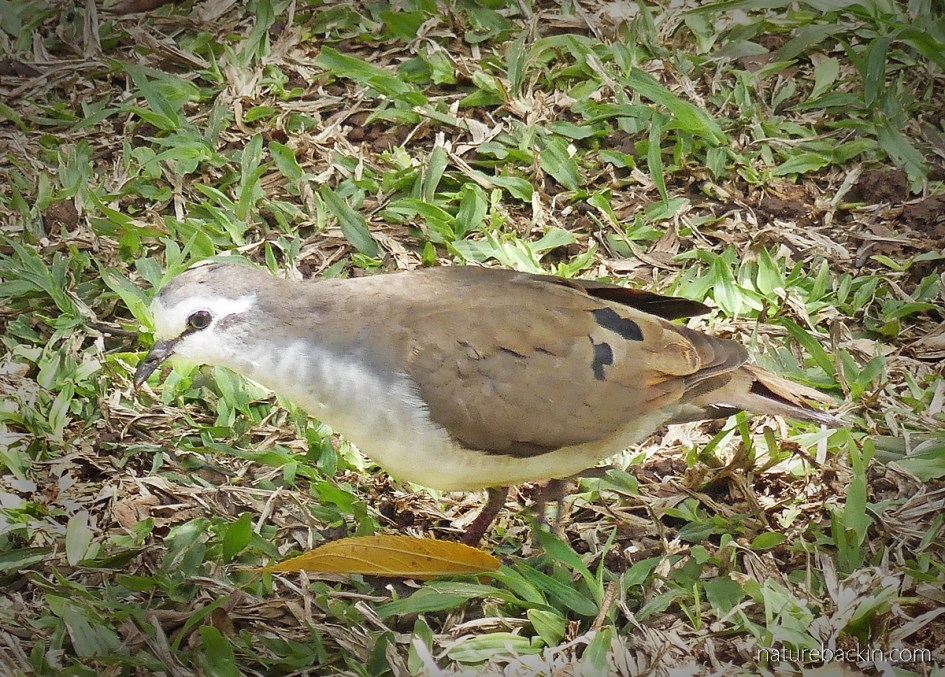
It then recommenced searching for food before flying down to the bird bath for a brief drink of water.
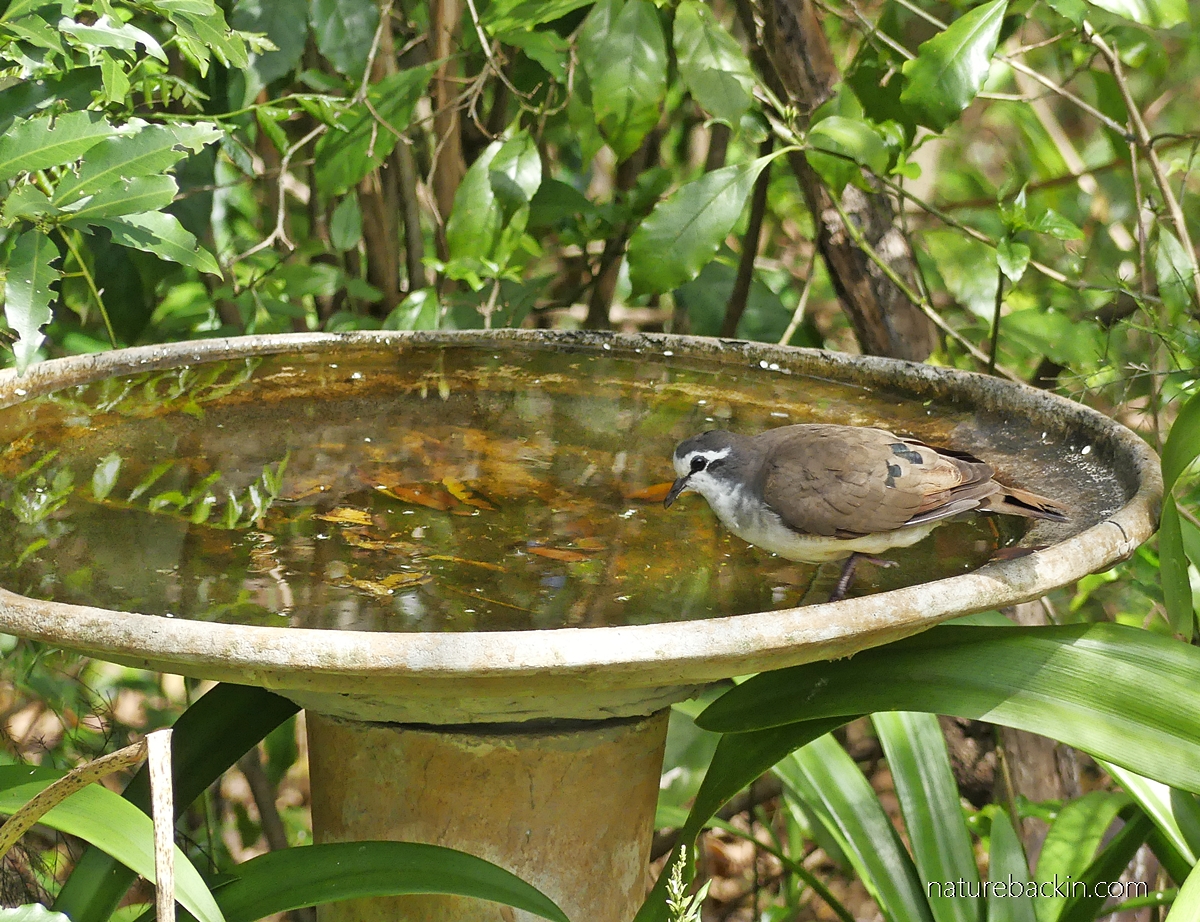
Tambourine doves are surprisingly small. At an average length of 22 cm and weight of 70 g, they are even smaller than the laughing doves, and considerably smaller than red-eyed doves that average 35 cm in length and 155 g in weight.
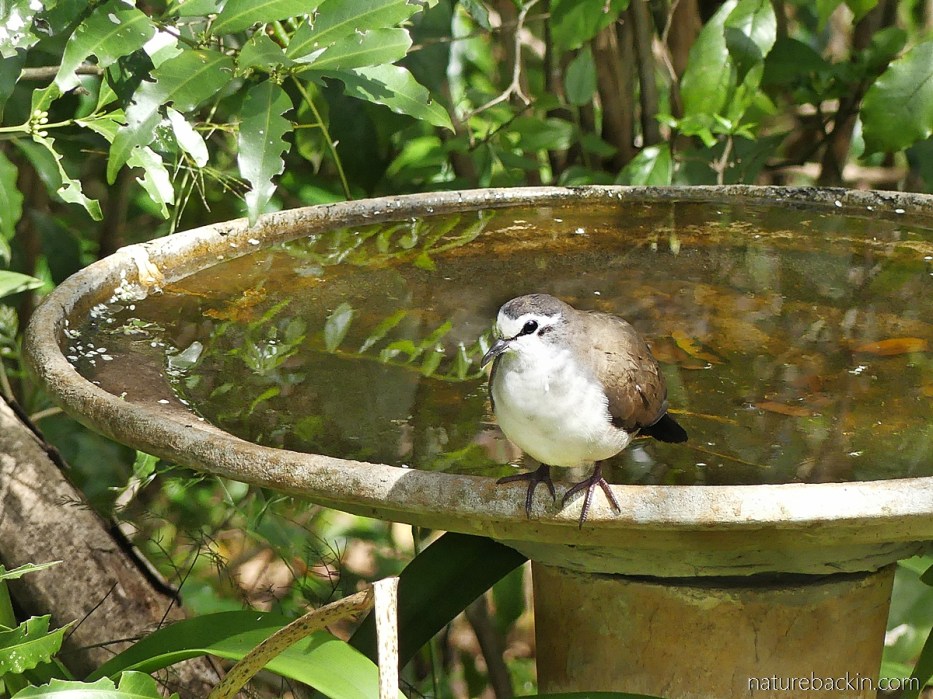
After a short drink of water, the tambourine dove paused on the edge of the bird bath before flying off. It was only by luck that I had seen the dove through the window, and watching it was very special as this is the best sighting I have had of this lovely dove, which I hear calling more often than I see.
I have a special fondness for doves and pigeons, and over time there have been several posts on the doves that visit our garden. Here are a few of them:
Love doves (You don’t know what you’ve got til its gone)
Redeyed doves, turtle doves, monogamy and sacrifice
Favourite garden birds: Laughing doves
The forest dwelling lemon dove
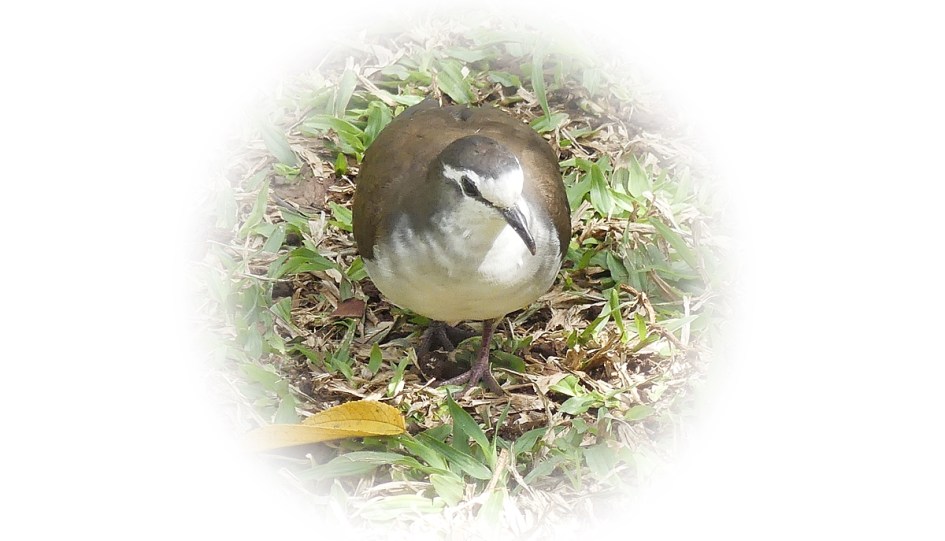
P.S. I am happy to report that my husband has made really good progress towards recovery this week. Thanks again for all the good wishes and kind support.
Sources:
Chittenden, Hugh, Davies, Greg & Weiersbye, Ingrid. 2016. Roberts Bird Guide: Illustrating nearly 1,000 Species in Southern Africa (2nd edition). Cape Town: Jacana.
Roberts VII Multimedia Birds of Southern Africa: PC Edition. 1997-2016 Southern African Birding. For details go to http://www.sabirding.co.za/roberts7/portal.html
Posted by Carol









October 11, 2021 at 10:44 am
What a remarkable set of photographs. It was wonderful to feel part of your enchanting encounter with the tambourine dove.
LikeLike
October 12, 2021 at 5:50 am
It was so unusual and great to be able to take some photos to share ☺
LikeLike
October 11, 2021 at 3:36 am
Truly good news about your husband. It’s also delightful to see you posting again. Especially these wonderful shots of your colorful dove. The sound of the Tambourine Dove recording sent my partner in the other room outside to investigate. (The volume was down pretty low on the 1st recording. So the 2nd one came blasting out because I had cranked the volume way up! It was rather funny. I think Eric maybe thought there was some rare one visiting us in the dead of night!) 😉
LikeLike
October 12, 2021 at 5:48 am
Thanks Gunta. I had to smile at the recording of the tambourine dove call misleading Eric. Easy to imagine ☺
LikeLike
October 10, 2021 at 3:50 am
Glad to hear your husband is getting better. The dove is quite lovely and the wing color is beautiful. I love these kinds of unexpected encounters, looking up or out at the exact moment to see something that one might otherwise have missed entirely and perhaps never have the chance to see again. Lucky you!
LikeLiked by 1 person
October 12, 2021 at 5:44 am
Thanks Graham. Those lucky chance encounters are even better when one has the time to take advantage and really watch and even take photos. More often they are enticingly fleeting …
LikeLiked by 1 person
October 12, 2021 at 6:10 am
I agree.
LikeLiked by 1 person
October 9, 2021 at 6:09 pm
What a beautiful bird! I love when you get those chance window visits. We have mourning doves here, which are skittish, as well. They are much larger, but they do hang on the ground and even on our paved driveway.
LikeLiked by 1 person
October 12, 2021 at 5:40 am
Yes, it is a particularly lovely dove, although I think they all have a lovely evening if more subtle beauty. I have just looked up your mourning dove and I see that it also has dark spots on the wings.
LikeLiked by 1 person
October 9, 2021 at 4:36 pm
Lovely news about your husband, long may it continue. What a joy to watch this beautiful dove and capture its beauty. It provided a marvellous display. A privilege too, to see those rare glimpses of colour in its plumage. Thank you for sharing these, Carol.
LikeLiked by 1 person
October 12, 2021 at 5:33 am
It was lucky and special to see the dove so relaxed and revealing its beautiful plumage. My husband is continuing towards recovery, thanks Sandra.
LikeLiked by 1 person
October 8, 2021 at 12:01 pm
What a privileged view you have had of this (usually) rather elusive dove. It certainly was very co-operative. Good for you making the most of documenting its colour and movements. You have been in my thoughts so I am relieved to read the positive news about your husband’s recovery. I hope the path ahead remains a clear and relatively smooth one!
LikeLike
October 8, 2021 at 6:25 pm
It was unique seeing a tambourine dove being so relaxed, and lucky I had a clear view of it for the most part through the window,
Thanks very much Anne for your thoughts and good wishes. The path is still a bit bumpy at times but mostly there is good progress towards recovery.
LikeLiked by 1 person
October 8, 2021 at 8:44 am
What a wonderful encounter and for me too as have never heard of tambourine doves. Good to hear your husband is recovering well. Blessings to you both and all the wonderful wildlife around you.
LikeLiked by 1 person
October 8, 2021 at 6:22 pm
It was a special encounter, and thanks so much for your kind wishes. Sending best wishes to you too.
LikeLiked by 1 person
October 8, 2021 at 7:43 am
Great news about your husband! Hope this upwards journey continues. And what luck too to have this sighting. I’ve just been listening to the recording: so different from any dove we have here in the UK.
LikeLiked by 1 person
October 8, 2021 at 6:21 pm
Thanks Margaret – yes hoping that my husband continues to be on the mend.
The call of the tambourine dove is lovely but not really much like a tambourine to my ears even though the call is quite resonant. There is another dove (the green spotted dove) that has a very similar call, but it does not occur in our area.
LikeLiked by 1 person
October 8, 2021 at 5:00 am
Such a special sighting. So thrilled that you were able to spot the dove, grab your camera, pay attention – and then share with us all! Thank you.
LikeLiked by 1 person
October 8, 2021 at 6:18 pm
Thanks Nikki – I spotted the dove just by luck and it was also lucky that I was able to get a clear view of it most of the time – and that it was relatively uninhibited too was a bonus!
LikeLike
October 8, 2021 at 4:27 am
I am glad that this lovely bird decided to spend some time with you. Very glad to hear your husband continues to feel better. Wishing you both a lovely weekend ahead.
LikeLiked by 1 person
October 8, 2021 at 6:16 pm
Indeed it is a very lovely bird and it was special to watch it being relatively relaxed.
Thanks Takami, my husband is very much on the mend. I hope you have a lovely weekend too.
LikeLiked by 1 person
October 8, 2021 at 4:02 am
Such a joy to have moments of beauty like this and manage to capture them, gorgeous! So pleased your husband’s health is improving, xxx
LikeLiked by 1 person
October 8, 2021 at 6:14 pm
That little dove certainly made my day. It is such a relief that my husband has started feeling better and on the mend. Thanks Christeen xxx
LikeLiked by 1 person
October 8, 2021 at 3:25 am
What a wonderful encounter with this beautiful dove!
And glad to hear your husband is progressing well.
LikeLiked by 1 person
October 8, 2021 at 2:08 am
You’ve certainly made the best of this impromptu photo shoot, Carol. Marvelous photographs of a bird that is usually very skittish.
And I’m very glad to read that your husband’s condition has made such a marked improvement!
LikeLiked by 1 person
October 8, 2021 at 6:12 pm
That little dove was completely surprising!
Thanks yes, my husband condition continues to improve – so grateful for that.
LikeLiked by 1 person
October 7, 2021 at 11:31 pm
It seemed to be showing off for you! Such a lovely bird.
Glad your spouse is doing much better!
LikeLiked by 1 person
October 8, 2021 at 6:10 pm
The dove was so unusual for a species normally so shy. And thanks yes it is a great relief that my spouse is recovering.
LikeLiked by 1 person